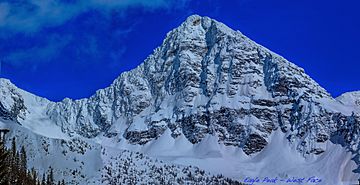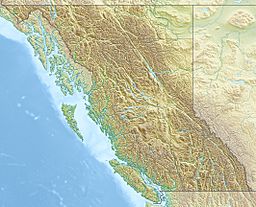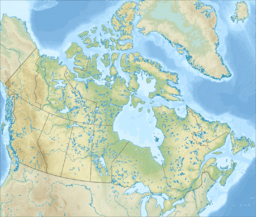Eagle Peak (British Columbia) facts for kids
Quick facts for kids Eagle Peak |
|
|---|---|

Eagle Peak (west face) seen from the Trans-Canada Highway
|
|
| Highest point | |
| Elevation | 2,846 m (9,337 ft) |
| Prominence | 166 m (545 ft) |
| Parent peak | Uto Peak (2927 m) |
| Geography | |
| Location | British Columbia, Canada |
| Parent range | Selkirk Mountains |
| Topo map | NTS 82N06 |
| Climbing | |
| First ascent | 1893 Samuel E.S. Allen, Walter D Wilcox |
| Easiest route | Scrambling YDS 3 |
Eagle Peak is a tall mountain in Glacier National Park. It stands 2,846-metre (9,337-foot) high. You can find it in the Selkirk Mountains in British Columbia, Canada.
This peak is close to other famous mountains. Uto Peak is its nearest higher neighbor, just 1.0 km (0.62 mi) to the east. Mount Sir Donald is 2.0 km (1.2 mi) southeast. Mount Macdonald is 4.0 km (2.5 mi) to the north. The Avalanche Glacier sits on the northeast side of Eagle Peak. Travelers on Highway 1, the Trans-Canada Highway, can see the peak when heading towards Rogers Pass.
The Story Behind Eagle Peak
Eagle Peak got its name from Harry Perley. He was the manager of the Glacier House hotel. He noticed a rock formation on the mountain's west side. It looked just like the head of an eagle.
The first people to climb Eagle Peak were Samuel Allen and Walter Wilcox. They reached the top in 1893. Wilcox later wrote about their adventure in a book. He described the "eagle" rock as a huge, leaning tower. It was about 60 feet (18 meters) tall.
Wilcox wrote that the rock seemed to hang over a very deep drop. He also said the area near the top was very rocky. Frost and storms had broken the rocks into giant blocks. Between these blocks, climbers could see the valley far below. He felt the view from the top was amazing. He said it was worth all the hard work to climb it.
The name "Eagle Peak" became official in 1932. The Geographical Names Board of Canada approved it.
What's the Weather Like?
Eagle Peak has a subarctic climate. This means it has very cold and snowy winters. The summers are mild, not too hot. Temperatures can drop below −20 °C (minus 4 °F). With the wind, it can feel even colder, below −30 °C (minus 22 °F).
Water from the melting snow and ice flows off the mountain. This water goes in two directions. Some flows west into the Illecillewaet River. Other water flows east into the Beaver River.



